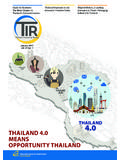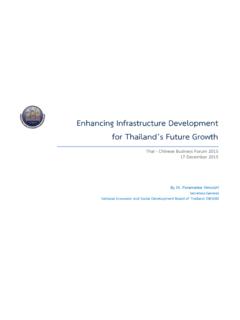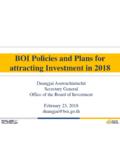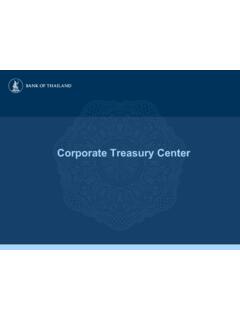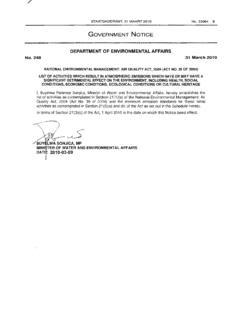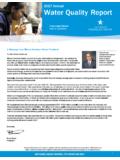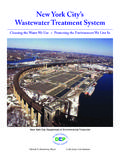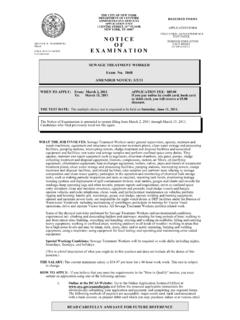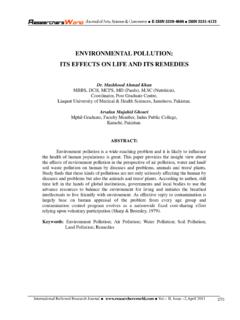Transcription of THAILAND BOARD OF INVESTMENT GUIDE ON …
1 THAILAND BOARD OF INVESTMENT GUIDE ON environmental REGULATIONS 12/19/2014 2 Table of Contents I. The Environment in THAILAND .. 4 II. Overview of EIA Proceedings .. 5 A. environmental Impact Assessment (EIA) .. 10 B. environmental Health Impact Assessment (EHIA) .. 29 C. Comparison Between an EIA and an E/HIA .. 36 D. Initial environmental Examination (IEE) .. 36 E. environmental Safety Assessment (ESA) .. 39 III. BOI environmental Regulations .. 42 A. Types of Activities and Associated Forms .. 43 B.
2 Promoted Activities that Require an EIA and EIA Approval (after the issuance of BOI Certification) .. 46 C. Promoted Activities that Require an EHIA and EHIA Approval (before the issuance of BOI Certification) .. 53 D. Projects Located in the Chaophraya River Basin that Require Factory Licensing (before the issuance of BOI Certification) .. 57 E. Regulation of Emissions (NOx, SOx, and VOCs) for Projects Located in Rayong .. 58 IV. Auxiliary environmental Laws and Regulations .. 59 A. Water .. 61 B. Soil .. 64 C. Air .. 70 D. Odors .. 72 E. Noise .. 73 F. Waste & Hazardous Waste.
3 78 G. Indicators of Pollution .. 80 H. Regulations of Industrial Pollution Control Facilities .. 82 V. Responsible Government Agencies .. 85 A. Ministry of Natural Resources and Environment .. 85 B. Office of Natural Resources and environmental Policy and Planning .. 85 C. Pollution Control Department .. 85 D. Ministry of 85 E. Department of Industrial Works .. 85 F. Industrial Estate Authority of THAILAND .. 85 3 Table of Contents (cont.) VI. Annexes .. 86 Annex I. Qualifications of EIA Specialist .. 86 Annex II. EIA Report Forms (Sor Por 1, 2, 3, 5, 6, 7, 8, and 9) as mandated by the Ministry of Natural Resources and Environment.
4 91 Annex III. Preliminary environmental Impact Evaluation Form .. 99 4 THAILAND BOARD OF INVESTMENT GUIDE ON environmental REGULATIONS I. The Environment in THAILAND Economic performance and environmental situation go hand in hand. The natural environment is central to economic activity and growth, providing the resources a country requires to produce goods and services, and absorbing and processing unwanted by-products in the form of pollution and waste. environmental assets contribute to managing risks to economic and social activity, helping to regulate flood risks, regulating the local climate (both air quality and temperature), and maintaining the supply of clean water and other resources.
5 This underpins economic activity and wellbeing, and so maintaining the condition of natural assets is a key factor in sustaining growth for the longer term. Correspondingly, economic growth contributes to the INVESTMENT and dynamism needed to develop and deploy new technology, which is fundamental to both productivity growth and managing environmental assets. Indeed, the natural environment plays an important role in supporting economic activity. It contributes directly, by providing resources and raw materials such as water, timber and minerals that are required as inputs for the production of goods and services; and indirectly, through services provided by ecosystems including carbon sequestration, water purification, managing flood risks, and nutrient cycling.
6 Natural resources are, therefore, vital for securing economic growth and development, not just today but for future generations. As such, the role of environmental policy is to manage the provision and use of environmental resources in a way that supports improvements in prosperity and wellbeing, for current and future generations. There are a number of reasons why government intervention is needed to achieve this. In particular, market failures in the provision and use of environmental resources mean that natural assets would be over-used in the absence of government intervention.
7 These market failures arise from the public good characteristics of the natural environment; external costs and benefits where the use of a resource by one party has impacts on others; difficulties in capturing the full benefits of business INVESTMENT in environmental R&D; and information failures. As the second largest economy in Southeast Asia, THAILAND confronts a number of increasingly pressing environmental challenges, such as: climate change (frequent flooding, drought, higher temperatures, and rising sea levels); intensive farming (usage of pesticides, herbicides, fertilizers, and irrigation); water pollution (urban runoff, ship transport, untreated sewage, septic tanks, animal feces, manure spreading, acid rain, and eutrophication).
8 Air pollution (automobiles, factories, aircraft, refineries, smog, slash and burn), resource depletion (overfishing, deforestation, water scarcity, land degradation, soil desertification, habitat destruction, and biodiversity loss); and waste generation (e-waste, medical waste, household waste, industrial waste, marine debris, river dumping, and landfills). 5 II. Overview of EIA Proceedings environmental management and administration in THAILAND officially started in 1975 with the passage of the Enhancement and Conservation of National environmental quality Act, 2518 (1975).
9 The translation of the act into policy, programs, plans, and compliance systems was then undertaken in a compartmentalized, segmented manner according to the functional responsibility of each of the relevant government agencies. In 1992, a new environmental Act was issued in order to reform the management of natural resources and environmental conservation, based on effective, transparent and accountable monitoring. The new Act also enhances public participation, decentralizing management authority to local authorities and adheres to the 'polluter pays' principle.
10 Simply put, the owner or possessor of the pollution source is held responsible for all costs of construction and operation of their treatment facilities or the payment of service fees to send their waste to the government s central treatment/disposal plant. Large-scale ventures with significant environmental or surrounding habitat impact must forward environmental Impact Assessment reports (EIA) to the Office of Natural Resources and environmental Policy and Planning (ONEP), which then submits preliminary comments to the Expert Review Committee (ERC) for consideration.

